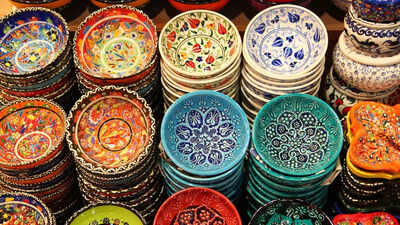ARTICLE AD BOX

The Ottoman Empire left behind a rich artistic heritage, and among its most admired crafts was Iznik pottery. This art form began in the small Turkish town of Iznik and flourished from the late 15th to the 17th century.
Known for its bright colours, detailed floral designs, and fine workmanship, Iznik pottery was more than decoration. It represented grace, faith, and the spirit of a growing empire. The artists combined ideas from Chinese porcelain, Persian art, and Islamic geometry to create a new style that became uniquely Ottoman. Today, Iznik ceramics are seen as treasures of design, history, and creativity that still inspire people around the world.
The history and evolution of Iznik ceramics in the Ottoman Empire
Iznik pottery started as part of older Anatolian traditions but gained importance when the Ottoman court began supporting local artisans in the 15th century. At that time, Chinese blue-and-white porcelain was popular across Asia and Europe. Ottoman craftsmen admired it and began experimenting with similar styles. They used a quartz-based clay that allowed smooth surfaces and bright colours.In the beginning, they copied Chinese motifs such as peonies, lotus flowers, and cloud shapes.
But soon, their own artistic language developed. By the rule of Sultan Suleiman the Magnificent in the 1500s, Iznik pottery had become distinct and deeply Ottoman. Artists began using strong shades of cobalt blue, turquoise, and emerald green, along with the famous tomato red that became their hallmark.The demand for Iznik work grew fast. Tiles decorated mosques, tombs, and palaces, showing the empire’s wealth and taste.
The Süleymaniye Mosque in Istanbul still displays these intricate designs, standing as proof of how art, faith, and architecture were closely connected in Ottoman life. This period marked the peak of Iznik’s evolution, where simple clay turned into a reflection of imperial pride and devotion.
Distinct design elements and symbolic motifs in Iznik art
The charm of Iznik pottery lies in its balance of simplicity and detail. The artists used a clean white base and layered it with vivid colours like deep blue, turquoise, sage green, and a glowing red.
Each colour had meaning. Blue stood for peace and spirituality, while red expressed energy and life.The designs were rich with symbols. Tulips, carnations, and roses appeared often, each carrying a message. The tulip represented perfection and God’s unity, while the carnation stood for strength and love. The repeated floral patterns, calligraphy, and geometric forms reflected harmony and divine order.Every piece was carefully hand-painted, and the glazing technique gave the surface a glass-like shine.
The mix of floral and geometric patterns was not random. It followed principles of symmetry that mirrored the Ottoman sense of structure and discipline.The art was influenced by Persian miniatures and Byzantine designs but still kept its Islamic identity. This mix of styles gave Iznik pottery its distinctive look that could not be mistaken for any other ceramic tradition. It carried both visual beauty and cultural meaning, telling stories of faith, nature, and order through every curve and colour.
Cultural symbolism and architectural brilliance of Iznik tiles
Iznik tiles were a central feature in Ottoman architecture. They were not made just to decorate walls but to express the empire’s connection between art, faith, and daily life. Mosques, palaces, and tombs were covered in thousands of tiles that turned plain spaces into living works of art.The famous architect Mimar Sinan often worked with Iznik tilemakers to bring colour and texture into his buildings. One of the best examples is the Rüstem Pasha Mosque in Istanbul.
Inside, over 2,000 tiles cover every surface, filling the space with a pattern that feels endless.Each symbol on the tiles had spiritual meaning. The tulip symbolised God’s unity, the cypress tree represented eternal life, and geometric patterns reflected infinity. The polished glazes caught sunlight and filled interiors with a soft glow that created a calm, reflective atmosphere.Beyond Turkey, Iznik tiles became highly valued gifts in royal courts and were traded across Europe and Asia.
They were admired for their balance of beauty and precision. For the Ottomans, they showed the strength of their culture. For the world, they revealed how faith and art could blend into something timeless.
The enduring legacy and modern revival of Iznik Ottoman art
By the late 17th century, Iznik pottery began to fade. Economic troubles, reduced demand, and the loss of key materials led to its decline. Workshops closed, and the once-famous craft nearly disappeared. But centuries later, it began to return.Modern Turkish artisans, supported by museums and cultural institutions, have revived the old techniques. They still use quartz-based clay and hand-paint every design before firing it in kilns, just like their ancestors did. This revival is not only about preserving history. It is about keeping alive a skill that reflects national pride and artistic depth.Today, Iznik ceramics are displayed in museums like the Topkapi Palace Museum, the British Museum, and the Metropolitan Museum of Art. These collections show how Ottoman creativity influenced global art. Contemporary designers and architects also draw from Iznik patterns in modern projects, from wall décor and tableware to large-scale installations.The colours, symmetry, and floral themes continue to inspire today’s artists. For many, Iznik represents the meeting of tradition and innovation. It shows how old techniques can find new meaning in modern times.Also Read | What is Noctourism: The new nighttime travel trend taking adventurers into the world after dark

 8 hours ago
5
8 hours ago
5









 English (US) ·
English (US) ·